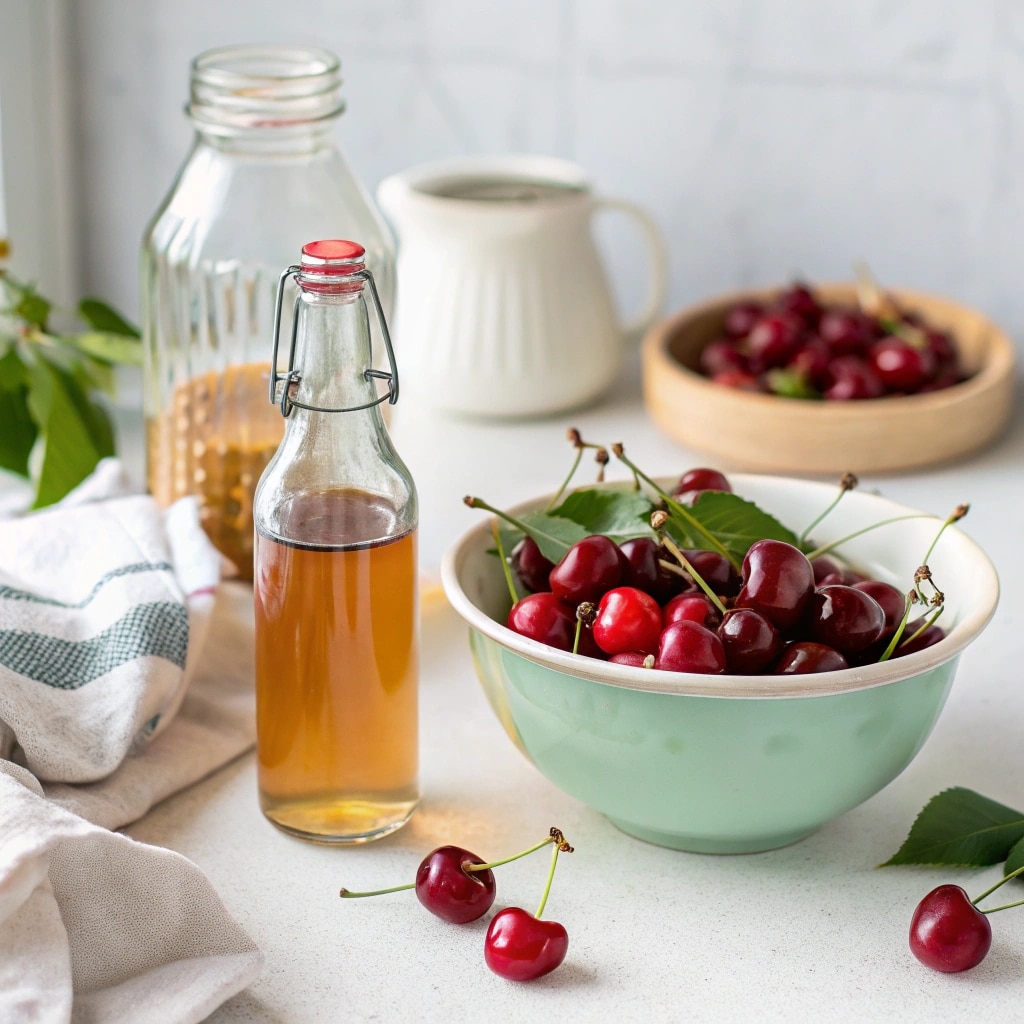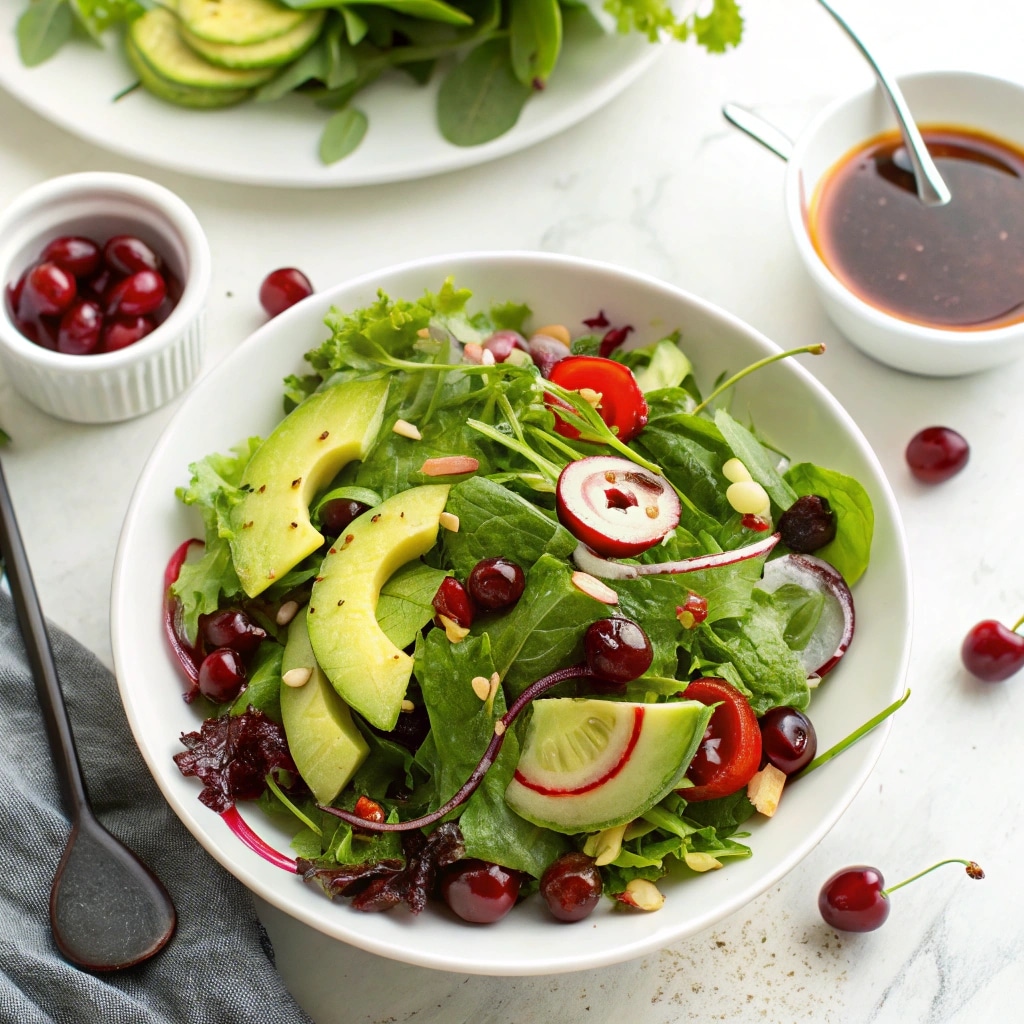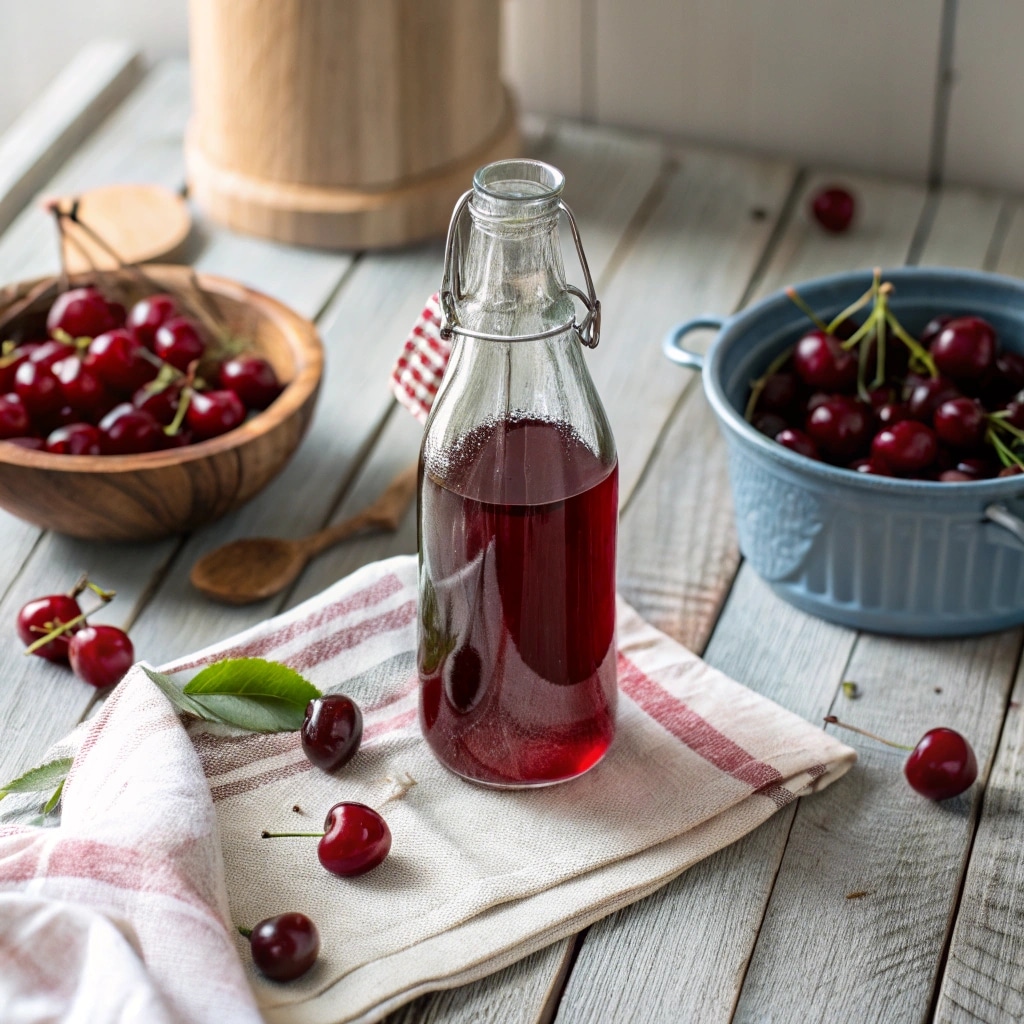If you’ve never made your own cherry vinegar, you’re in for a treat. This article breaks down how to create this bold, tangy vinegar using just two ingredients—and shows you all the ways it can replace red wine vinegar in salads, marinades, and even drinks. From my own kitchen story to pro storage tips, we’ll cover everything you need to know. You’ll also get answers to common questions like how cherry vinegar differs from red wine vinegar or what makes it a smart pantry swap.
How I Discovered the Magic of Cherry Vinegar
A Kitchen Memory from Cherries and Curiosity
Cherry vinegar wasn’t something I grew up with—but cherries? Absolutely. Back in Austin, my mom always had a bowl of them on the counter in summer. We’d pit them by hand for pies and jams, but it wasn’t until I left the corporate world and started experimenting with homemade condiments that cherry vinegar made its way into my life. I was craving something tangy with a bit of fruitiness to liven up a vinaigrette. Apple cider vinegar felt sharp, and balsamic was too sweet. A quick test batch with leftover cherries changed everything.
I crushed some cherries, added white wine vinegar, and let it steep for a week. When I tasted the result, it was tart but with a subtle sweetness and deep red hue—just what I didn’t know I needed. Ever since, it’s become a regular feature in my kitchen. I use it in glazes, quick pickles, and even drizzle a splash into sparkling water with a little honey for a homemade soda. Now I make a fresh batch every June, when cherries are ripe and flavorful.
This recipe works beautifully with both pitted and whole cherries. If using the latter, be sure the pits are uncracked—cherry pits can release cyanide if broken. After soaking, discard the cherries or strain the liquid into a clean jar and stash it in the fridge. Just like with my go-to cloud bread breakfast sandwich, the simplicity makes it shine.
Print
Cherry Vinegar: A Bright, Tangy Addition That Transforms Your Recipes
- Total Time: 10080
- Yield: 1.5 cups
- Diet: Vegan
Description
This homemade cherry vinegar recipe uses just two ingredients to create a fruity, tangy vinegar that’s perfect for dressings, marinades, and drinks.
Ingredients
1/2 cup cherries, pitted and chopped
2 cups apple cider vinegar (or white wine vinegar)
OR 1 cup whole cherries, lightly crushed with uncracked pits
Instructions
1. Add the cherries to a clean glass jar.
2. Pour in the vinegar until cherries are completely submerged.
3. Seal the jar with a plastic or cork lid (no metal).
4. Store in a cool, dark place for 1 week.
5. Strain out solids and transfer the vinegar to a clean container.
6. Refrigerate or store in a cool pantry.
Notes
If using whole cherries, ensure pits are uncracked—discard after soaking.
Great in vinaigrettes, marinades, glazes, and homemade cherry sodas.
- Prep Time: 5
- Category: Condiments
- Method: Infused Vinegar
- Cuisine: American
A Recipe That’s as Easy as It Is Useful
Cherry vinegar is surprisingly simple: two ingredients, one jar, a little patience. You can use fresh pitted cherries or whole, lightly crushed ones for a deeper flavor. The vinegar draws out all that rich cherry color and fruitiness without overpowering. If you’re a fan of easy prep like with my spinach feta egg bake, you’ll love this.
Let it sit in a cool, dark place—your pantry works just fine. After about a week, taste it. You’ll get that familiar acidity with just enough cherry brightness to surprise you. Store it with a cork or plastic lid (no metal), and you’ve got a bottle of kitchen magic ready for everything from salad dressing to a zippy marinade.
Table of Contents
Smart Ways to Use Cherry Vinegar in Everyday Recipes
Turn Ordinary Salads into Something Special
One of my favorite things about cherry vinegar is how effortlessly it upgrades a simple green salad. That bright tang with a hint of natural cherry flavor gives vinaigrettes a colorful twist without adding alcohol—perfect if you’re replacing red wine vinegar. I usually whisk it with olive oil, a touch of Dijon mustard, and a pinch of salt for a fast dressing that’s anything but boring. Try it over baby spinach with goat cheese and walnuts—it pops.
Cherry vinegar also shines in marinades. Whether you’re prepping chicken or tofu, it adds depth without overpowering the other ingredients. Combine it with garlic, soy sauce, and a little honey, and you’ve got a go-to blend for grilling season. I even use it as a glaze base for roasted vegetables—it’s got that sweet-sour punch that makes everything taste just a little more intentional.
In my brunch club days, I once drizzled it over roasted beets and served it with my savory bubble waffles. It might sound fancy, but it was so easy—and let me tell you, it had everyone asking what was in the dressing.

Ingredients for Cherry Vinegar
You can choose between chopped or whole cherries depending on the flavor depth and style you want. Both work well—just follow the pit safety note.
- ½ cup fresh cherries, pitted and chopped
–or– - 1 cup whole cherries, lightly crushed (with uncracked pits)
- 2 cups apple cider vinegar
–or white wine vinegar for a lighter taste
🔺 Cherry Pit Warning:
Cherry pits contain cyanogenic compounds and should never be crushed or eaten. Use whole, uncracked pits only, and always discard them after soaking.
Bubbly Refreshments and Bright Finishing Touches
Cherry vinegar isn’t just for savory dishes. One of the most surprisingly delightful ways to use it is in drinks. Mix a tablespoon or two with sparkling water and a drizzle of honey over ice, and you’ve got a homemade shrub that tastes way more gourmet than it should. The vinegar adds a tart edge, while the cherry keeps it smooth and fruity. It’s a little like sipping on a cherry soda with grown-up flair.
This kind of tangy soft drink feels right at home alongside a tahini iced coffee or as a non-alcoholic option for brunch guests. Want it sweeter? Add a dash of maple syrup instead of sugar for something more comforting.
You can even use cherry vinegar as a finishing splash—think grain bowls, lentil salads, or roasted squash. It brings brightness wherever you need it. If you love the idea of layering flavors but hate complicated prep, cherry vinegar gives you that elegant finish with zero stress.
Storing Cherry Vinegar & Comparing It to Other Pantry Staples
How to Store Cherry Vinegar for Maximum Freshness
Once your cherry vinegar has reached its full flavor—usually after about a week of steeping—it’s time to transfer it to a clean jar or bottle for storage. The most important thing? Use a plastic or cork lid. Metal lids can react with vinegar and affect the flavor over time. I recommend glass bottles (like the ones you might repurpose from maple syrup or olive oil) for keeping things fresh and safe.
You’ll want to keep your cherry vinegar in a cool, dark place. A pantry works great, or you can tuck it in the fridge if your kitchen runs warm. Just be sure the container is well-sealed. Properly stored, homemade cherry vinegar can last for several months, though mine never seems to last that long. I find myself reaching for it constantly—especially when I’m making a bright vinaigrette to pair with something cozy, like my spinach feta egg bake.
And don’t forget: if you used whole cherries with pits, be sure those pits stay uncracked throughout the soaking process. Crushed cherry pits can release toxins. Once the vinegar’s ready, strain and discard the solids. You’re left with a deep ruby red vinegar that’s as striking as it is flavorful.

Cherry Vinegar vs. Red Wine and Sherry Vinegar
So how does cherry vinegar stack up against more common options like red wine vinegar or sherry vinegar? Think of cherry vinegar as red wine vinegar’s fruitier cousin. It’s got the acidity, but also a round, subtle sweetness that makes it feel more delicate. Where red wine vinegar can sometimes overpower, cherry vinegar blends in smoothly—especially in dressings and glazes.
Sherry vinegar, on the other hand, tends to be deeper and nuttier. It’s lovely for deglazing pans or adding richness to soups, but it doesn’t offer the bright lift that cherry vinegar does. So while they’re not quite interchangeable, you can definitely experiment. If a recipe calls for sherry vinegar, try cherry vinegar in a lighter dish, like a citrus salad or a quick-pickled onion recipe. The result is tangy with a touch of fruit—not too sweet, not too sharp.
Need a backup? If you ever run out of cherry vinegar, you can mix apple cider vinegar with a bit of cherry juice as a close alternative. It won’t have the same complexity, but it’ll still bring some of that signature zing to the table.
Just like when experimenting with different toppings for a cloud bread breakfast sandwich, the key is to play with combinations and find what suits your palate best.
Cherry Vinegar Variations and Recipes to Try
Add a Personal Twist to Your Cherry Vinegar
One of the best parts of making cherry vinegar is how easy it is to customize. You can stick with the classic combo of cherries and apple cider vinegar—or experiment with white wine vinegar for a lighter flavor. But if you’re feeling adventurous, toss in a sprig of rosemary or thyme during the steeping phase. Fresh herbs infuse a subtle complexity that works beautifully in marinades and salad dressings.
Another variation I love is adding orange peel or a slice of ginger to the jar. Citrus brightens the vinegar even more, while ginger gives it a warming bite. Just make sure anything you add is clean and not overly wet, which helps keep your vinegar safe and shelf-stable. Once your mix has steeped for a week, strain it well, bottle it up, and label it so you don’t forget what’s inside.
Like how I tinker with different toppings for my tahini iced coffee, customizing vinegar is all about taste and simplicity. Keep your process relaxed, and don’t overthink it—you’re just steeping, straining, and storing.
Easy Recipe Ideas That Use Cherry Vinegar
You can drizzle cherry vinegar over roasted carrots, blend it into a simple tomato and cucumber salad, or use it to brighten a grain bowl. I especially love it in a warm barley salad with goat cheese and chopped pecans. The vinegar cuts through the richness and adds just the right lift.
For a sweet-savory pairing, use cherry vinegar in a cherry compote for topping pancakes or waffles—it balances out the sugar and adds dimension. Or stir it into a reduction for a tangy glaze over seared chicken. Think of it as a flavor shortcut: just a splash, and everything tastes a bit more polished.
And don’t forget those creative drinks—sparkling cherry vinegar refreshers are now a permanent fixture at my weekend brunches, served alongside bites like savory bubble waffles or simple egg dishes.
for more recipes follow me in facebook in pinterest.
FAQs: Cherry Vinegar Questions Answered
What is cherry vinegar used for?
Cherry vinegar is a versatile kitchen ingredient. Use it in salad dressings, marinades, glazes, and even drinks. Its fruity tang works well with both savory and sweet recipes.
Is cherry vinegar the same as red wine vinegar?
No. While both are acidic, cherry vinegar has a subtle sweetness and a distinct cherry flavor. Red wine vinegar is more robust and slightly sharper.
What can I use instead of cherry vinegar?
Try apple cider vinegar with a splash of cherry juice. You can also use raspberry vinegar or red wine vinegar if you’re not aiming for a fruity twist.
What is sherry vinegar best used for?
Sherry vinegar is ideal for deglazing, sauces, and recipes that need a nutty, aged flavor. It’s richer and more complex compared to cherry vinegar.

